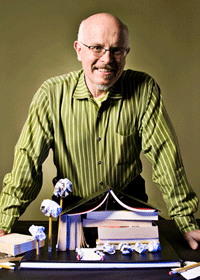In April, Jan Lorenc toured East Asia to introduce the new Chinese and Korean translations of the book he coauthored with Craig Berger and Lee Skolnick: What Is Exhibition Design? Speaking at the KODFA (Korean Design Firms Association) in Seoul, Lorenc described why he keeps his firm small, his business mentality, and how building strong client relationships and taking risks have paid off to create a diverse and satisfying portfolio of work over 32 years in business.
“Our firm is made up of architects, interior designers, industrial designers, and graphic designers,” Lorenc said. Over the last 32 years we’ve been no larger than 15 people. We’ve decided to pursue a different model than most firms by forming partnerships with firms in places from Seoul to Dubai to Philadelphia. Instead of growing our firm to be bigger, we’ve decided to form loose associations that allow us to have opportunities in new markets.”
Lorenc+Yoo Design’s partnerships include Journey Communications in Philadelphia, 607, Inc and CDR in Seoul, and HQ Creative in Dubai.
“When I first came to Dubai I looked at the architecture that was built 100 years ago,” Lorenc said. “But that really isn’t the culture of the place. One of our collaborators was tasked with designing a fountain, and he traveled around the Emirates, and he took samples of sand. He found beige sand, green sand, yellow sand: 17 different colors of sand. When he presented his design for the fountain using glass made from those different colors, the client really felt it was part of his heart and soul. If you operate in different areas, you’re going to have to find something to pull at your client’s heart.”
Lorenc showed the example of the entrance to a mixed-use development in Abu Dhabi called Mohammed bin Zayed City. “We designed the entrance into the town, lined with light totems in the landscape. This is a section of Abu Dhabi where there are going to be 320,000 people living and working. In an urban design context, we try to simplify the number of pieces in the landscape. Here, we combined light standards with signage so we minimized the footprint these elements take up in the urban landscape.”
LYD completed most of its work in the Middle East during the recent boom, the period prior to the current recession during which the desert populated almost overnight with skyscrapers and destination resorts. Now, like in the United States, development in Dubai and the region has slowed and new projects are relatively sparse. While there is no doubt business will pick up again, Lorenc says such situations can tempt design firms to compromise good business sense in exchange for short term gains.
 “When we first had the opportunity to work on projects in Korea, many clients asked us to do free design to get into the marketplace,” said Lorenc. “This is something I’ve made a conscious decision not to do. We’ve decided to do all our work for a fee. The reason being, with a fee, you’re valued as a valuable player in the project. If I give myself away, on the other hand, I’m giving away the best of what we’re capable of doing for no cost. The client doesn’t have any risk, and we take all the risk. What happens is these projects don’t go anywhere, and it’s disappointing.”
“When we first had the opportunity to work on projects in Korea, many clients asked us to do free design to get into the marketplace,” said Lorenc. “This is something I’ve made a conscious decision not to do. We’ve decided to do all our work for a fee. The reason being, with a fee, you’re valued as a valuable player in the project. If I give myself away, on the other hand, I’m giving away the best of what we’re capable of doing for no cost. The client doesn’t have any risk, and we take all the risk. What happens is these projects don’t go anywhere, and it’s disappointing.”
Lorenc says this kind of mentality can eventually run good firms out of business, and creates a competitive situation that drives not only prices down, but also, unfortunately, the quality of the design.
One way for firms to weather economic downturns is to be able to call on well-developed business relationships with past clients. LYD’s method to building solid business relationships relies on including top decision-makers in the design process.
“The client connections we’ve had as a firm have always been with top executives,” Lorenc said. “When we get involved in a meeting in the United States, we may have two other people involved. We make a decision and move forward. On the other hand, I have meetings in Korea where there are 30 people. It takes two days to discuss the project and no decisions are made.”
“It’s valuable to have the connection with the executives as opposed to having a discussion with others lower in the hierarchy. Having that relationship at the upper level has been instrumental in our building a portfolio I’m proud of.”
Marketing, Lorenc says, is different for creative firms than for those in any other industry. “When I travel to places like China I can call on the people I know to connect me with others. No media or advertising firm is going to work for us. It’s all about relationships. It’s people believing you’re going to be of value to them in the end, and not about comparing you to someone else only in terms of price.”
“We’ve taken risks over the past 32 years, risk that has been stabilized by a solid financial foundation,” Lorenc says. “We take risks when we visit clients across the world, and maybe nothing will come of it for a number of years. But we take that risk because we believe we can work this way and we can work this way.”